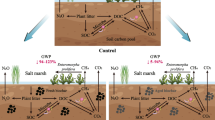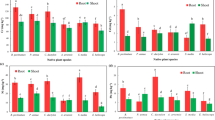Abstract
Acid mine drainage (AMD) poses serious environmental problems. This study assessed the effect of plant age, rhizosphere bacteria, and citric acid (CA) on the metal plaque formation and metal uptake in Phragmites australis cultured in a synthetic AMD solution. Iron-oxidizing bacteria (Fe(II)OB) enhanced the formation of Fe plaque, which slightly decreased Fe and Mn uptake. CA reduced the growth of Fe(II)OB and formation of Fe plaque, thereby increasing the Fe and Mn accumulations in reeds. Adult reeds had developed more Fe plaque on the root surface than seedlings. However, the adult reeds still accumulated higher concentrations of metals due to their higher tolerance to toxic environments and bigger biomass. With 9.02 g/L CA, adult reeds accumulated 0.51 ± 0.00 mg Mn, 109.38 ± 1.37 mg Fe, and 1.77 ± 0.04 mg Al. More investigation may be needed to further study the effect of CA when applied to AMD-contaminated field.



Similar content being viewed by others
References
Abhilash, P. C., Srivastava, S., Srivastava, P., Singh, B., Jafri, A., & Singh, N. (2011). Influence of rhizospheric microbial inoculation and tolerant plant species on the rhizoremediation of lindane. Environmental and Experimental Botany, 74, 127–130.
Ali, B., Huang, C. R., Qi, Z. Y., Ali, S., Daud, K., Geng, X. X., Liu, H. B., & Zhou, W. J. (2013). 5-Aminolevulinic acid ameliorates cadmium-induced morphological, biochemical and ultrastructural changes in seedlings of oilseed rape. Environmental Science and Pollution Research, 20, 7256–7267.
Ali, B., Song, W. J., Hu, W. Z., Luo, X. N., Gill, R. A., Wang, J., & Zhou, W. J. (2014). Hydrogen sulfide alleviates lead-induced photosynthetic and ultrastructural changes in oilseed rape. Exotoxicology and Environmental Safety, 102(25–33), 2014.
Akcil, A., & Koldas, S. (2006). Acid mine drainage (AMD): causes, treatment and case studies. Journal of Cleaner Production, 14(12–13), 1139–1145.
Asao, T. (2012). Hydroponics—a standard methodology for plant biological researches. Croatia: Intech.
Baldantoni, D., Ligrone, R., & Alfani, A. (2009). Macro- and trace-element concentrations in leaves and roots of Phragmites australis in a volcanic lake in Southern Italy. Journal of Geochemical Exploration, 101(2), 166–174.
Batty, L. C., Baker, A. J. M., Wheeler, B. D., & Curtis, C. D. (2000). The Effect of pH and plaque on the uptake of Cu and Mn in Phragmites australis (Cav.) Trin ex. Steudel. Annals of Botany, 86(3), 647–653.
Batty, L. C., Baker, A. J. M., & Wheeler, B. D. (2002). Aluminum and phosphate uptake by Phragmites australis: the role of Fe, Mn and Al root plaques. Annals of Botany, 89(4), 443–449.
Bell, P. F., McLaughlin, M. J., Gozens, G., Stevens, D. P., Owens, G., & South, H. (2003). Plant uptake of 14C-EDTA, 14C-citrate, and 14C-histidine from chelator buffered and conventional hydroponic solutions. Plant and Soil, 253(2), 311–319.
Brantner, J., & Senko, J. M. (2014). Response of soil-associated microbial communities to the intrusion of acid mine drainage. Environmental Science and Technology, 48(15), 8556–8563.
Chen, R. F., Shen, R. F., Gu, P., Dong, X. Y., Du, C. W., & Ma, J. F. (2006). Response of rice (Oryza sativa) with root surface iron plaque under aluminum stress. Annals of Botany, 98(2), 389–395.
Cutright, T. J., Senko, J., Sivaram, S., & York, M. (2012). Evaluation of phytoextraction potential at an acid mine drainage (AMD) impacted site. Soil and Sediment Contamination: An International Journal, 21(8), 970–984.
De Sa, T. C., Brown, J. F., & Burgos, W. D. (2010). Laboratory and field-scale evaluation of low-pH Fe(II) oxidation at Hughes Borehole, Portage, Pennsylvania. Mine Water and the Environment, 29(4), 239–249.
Duquène, L., Vandenhove, H., Tack, F., Meers, E., Baeten, J., & Wannijn, J. (2009). Enhanced phytoextraction of uranium and selected heavy metals by Indian mustard and ryegrass using biodegradable soil amendments. Science of the Total Environment, 407(5), 1496–1505.
Ernst, W. H. O. (2006). Evolution of metal tolerance in higher plants. Forest Snow and Landscape Research, 80, 251–274.
Greipsson, S., & Crowder, A. A. (1992). Amelioration of copper and nickel toxicity by iron plaque on roots of rice (Oryza sativa). Canadian Journal of Botany, 70(4), 824–830.
Guo, L., & Cutright, T. J. (2014). Remediation of acid mine drainage (AMD) contaminated soil by Phragmites australis and rhizosphere bacteria. Environmental Science and Pollution Research, 21(12), 7350–7360.
Hallberg, K. B. (2010). New perspectives in acid mine drainage microbiology. Hydrometallurgy, 104, 448–453.
Jean-Soro, L., Bordas, F., & Bollinger, J. C. (2012). Column leaching of chromium and nickel form a contaminated soil using EDTA and citric acid. Environmental Pollution, 164, 175–181.
Johnson, D. B. (1995a). Acidophilic microbial communities: candidates for bioremediation of acidic mine effluents. International Biodeterioration and Biodegradation, 35(1–3), 41–58.
Johnson, D. B. (1995b). Selective solid media for isolating and enumerating acidophilic bacteria. Journal of Microbiological Methods, 23(2), 205–218.
Jones, D. L. (1998). Organic acids in the rhizosphere—a critical review. Plant and Soil, 205(1), 25–44.
Kosová, K., Vitamavas, P., Prasil, I. T., & Renaut, J. (2011). Plant proteome changes under abiotic stress—contribution of proteomics studies to understanding plant stress response. Journal of Proteomics, 74(8), 1301–1322.
Mihalík, J., Tlustoš, P., & Szaková, J. (2010). Comparison of willow and sunflower for uranium phytoextraction induced by citric acid. Journal of Radioanalytical and Nuclear Chemistry, 285(2), 279–285.
Morel, F. M. M., & Hering, J. G. (1993). Principles and applications of aquatic chemistry. New York, NY: John Wiley and Sons, INC.
Najeeb, U., Xu, L., Ali, S., Jilani, S., Gong, H. J., Shen, W. Q., & Zhou, W. J. (2009). Citric acid enhances the phytoextraction of manganese and plant growth by alleviating the ultrastructural damages in Juncus effusus L. Journal of Hazardous Materials, 170, 1156–1163.
Najeeb, U., Jilani, G., Ali, S., Sarwar, M., Xu, L., & Zhou, W. (2011). Insights into cadmium indusced physiological and ultra-structural disorders in Juncus effuses L. and its remediation through exogenous citric acid. Journal of Hazardous Materials, 186(1), 565–574.
Nealson, K. H., Tebo, B. M., & Rosson, R. A. (1988). Occurrence and mechanisms of microbial oxidation of manganese. Advances in Applied Microbiology, 33, 279–318.
Peralta-Videa, J. R., de la Rosa, G., Gonzalez, J. H., & Gardea-Torresdey, J. L. (2004). Effects of the growth stage on the heavy metal tolerance of alfalfa plants. Advances in Environmental Research, 8, 679–685.
Perez-Esteban, J., Escolastico, C., Moliner, A., & Masaguer, A. (2013). Chemical speciation and mobilization of copper and zinc in naturally contaminated mine soils with citric and tartaric acid. Chemosphere, 90(2), 276–283.
Robinson, B. H., Chiarucci, A., Brooks, R. R., Petit, D., Kirkman, J. H., Gregg, P. E. H., & Dominicis, V. D. (1997). The nickel hyperaccumulator plant Alyssum bertolonii as a potential agent for phytoremediation and phytomining of nickel. Journal of Geochemical Exploration, 59(2), 75–86.
Rofkar, J. R., & Dwyer, D. F. (2011). Effects of light regime, temperature, and plant age on uptake of arsenic by Spartina pectinata and Carex stricta. International Journal of Phytoremediation, 13(6), 528–537.
Senko, J. M., Wanjugi, P., Lucas, M., Bruns, M. A., & Burgos, W. D. (2008). Characterization of Fe(II) oxidizing bacterial communities at two acidic Appalachian coal mine drainage impacted sites. The International Society for Microbial Ecology Journal, 2(11), 1134–1145.
Silva, I. R., Smyth, T. J., Israel, D. W., Raper, C. D., & Rufty, T. W. (2001). Magnesium ameliorates aluminum rhizotoxicity in soybean by increasing citric acid production and exudation by roots. Plant and Cell Physiology, 42(5), 546–554.
Sobolev, D., & Roden, E. E. (2001). Suboxic deposition of ferric iron by bacteria in opposing gradients of Fe(II) and oxygen at circumneutral pH. Applied and Environmental Microbiology, 67(3), 1328–1334.
Taylor, G. J., & Crowder, A. A. (1983). Use of the DCB technique for extraction of hydrous iron oxides from roots of wetland plant. American Journal of Botany, 70(8), 1254–1257.
Taylor, G. J., Crowder, A. A., & Rodden, R. (1984). Formation and morphology of an iron plaque on the toots of Typha latifolia L. grown in solution culture. American Journal of Botany, 71(5), 666–675.
Weis, J. S., & Weis, P. (2004). Metal uptake, transport and release by wetland plants: implications for phytoremediation and restoration. Environment International, 30(5), 685–700.
White, J. C., Mattina, M. I., Lee, W. Y., Eitzer, B. D., & Iannucci-Berger, W. (2003). Role of organic acids in enhancing the desorption and uptake of weathered p, p-DDE by Cucurbita pepo. Environmental Pollution, 124(1), 71–80.
Ye, Z. H., Baker, A. J. M., Wong, M. H., & Willis, A. J. (1997). Copper and nickel uptake, accumulation and tolerance in Typha latifolia with and without iron plaque on the root surface. New Phytologist, 136(3), 481–488.
Ye, Z. H., Cheung, K. C., & Wong, M. H. (2003). Cadmium and nickel adsorption and uptake in cattail as affected by iron and manganese plaque on the root surface. Communications in Soil Science and Plant Analysis, 34, 2763–2778.
Zhang, X., Zhang, F., & Mao, D. (1998). Effect of iron plaque outside roots on nutrient uptake by rice (Oryza sativa L.): zinc uptake by Fe-deficient rice. Plant and Soil, 202(1), 33–39.
Author information
Authors and Affiliations
Corresponding author
Rights and permissions
About this article
Cite this article
Guo, L., Cutright, T.J. & Duirk, S. Effect of Citric Acid, Rhizosphere Bacteria, and Plant Age on Metal Uptake in Reeds Cultured in Acid Mine Drainage. Water Air Soil Pollut 226, 2264 (2015). https://doi.org/10.1007/s11270-014-2264-7
Received:
Accepted:
Published:
DOI: https://doi.org/10.1007/s11270-014-2264-7




